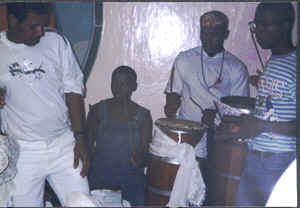
Axé
The union of medium and spirit is attained through intense dancing to specific rhythms designated for each Orixá.
From the traditions of Africa to the terreiros of Candomblé, the drums provide the sacred rhythms and means of communication. According to Mãe Elise the mãe de santo of Brazil’s most famous and influential terreiro, Terreiro Axé Opo Afonjá, the drums are the communicators for the Candomblé, summoning the orixas from distant Africa. All of the ceremonies are led by the rhythms of the atabaques (sacred drums of the Candomblé). The orchestra consists of three atabaques and a two tone bell named agogo. The first atabaque is rum (pronounced hoom). Rum is the largest and deepest drum which is played by the master drummer for it follows the movement and space of the dancers’ bodies and provides a rhythmical interpretation of the African mythology of the orixá. The middle drum is called, rumpi (hoom-pee). Rumpi is the base rhythm of the smaller drum and the variant of the rum. The smallest atabaque is called rumpile (hoom-pee-lay). Every base rhythm from the rumpile rhythmically mirrors the feet of the orixá.

Musicians playing the Atabaques in Ketu Style. (From left to right) The young man seated is playing Rumpile followed by Rumpi, and Rum. The gentelman with glasses (standing in front ot Rum) is playing the agogo.
The atabaques are considered to be living beings who possess the spiritual energy or axé. When a drummer approaches an atabaque he greets it by lying on the floor at the foot of each drum to show his utmost respect. Women are forbidden from playing the atabaques because of their menstrual cycles. It is believed that women are impure because of this natural cycle. Men who are going to play the atabaques must be pure as well. They must abstain from sex before playing the sacred drums. Atabaques are washed once every couple of months in a sacred herb water. This keeps the atabaques pure and full of life.
The agogo are two tone iron bells which provide the underlying pulse or "clave" of the music. This instrument may not appear to be very difficult because of its simplicity; however, the agogo player must keep the pulse steady throughout the sea of polyrythms produced by the orchestra of atabaques, making the performance more challenging auditorially. This vital instrument is derived from the gonkagui bells that were and are still used in Ghana.
One other instrument used in Candomblé is the adejá. The adejá is a ceremonial bell which is not part of the orchestra and is used by the mãe or pãe de santo. This sacred bell serves as an instrument of axé which is rung throughout the service at the mãe’s discretion. It does not serve as accompaniment for the music.
There are two methods of playing the atabaques, Ketú and Angola. Ketú is the most popular style of Candomblé music and is played with thin, flexible, hand carved wooden sticks called Aguidavi. Both the rumpi and rumpile drums are played with one stick in each hand. The rum is played with one stick with the free hand to enable the musician to alter the pitch of the drum with the movement of the dancers. Some Ketú traditional rhythms are aro, bravum, sa va lu, avamunha, alujá, batá and vásse. Angola style is the playing of the atabaques with hands only. This style has fewer traditional rhythms than Ketú. Some Angola rhythms are congo, barravento, and ijé xa. The use of these two different styles depends on each particular terreiro; however, the majority of Candomblés in Bahia use the Ketú style.
As vital as the atabaques are in the Candomblé ceremony there are some Candomblés in Brazil that do not use any music in their worship. These Candomblés are very rare in Brazil but must still be recognized. On the other hand, Terreiros like Axé Opo Afonjá include music in all ceremonies ranging from baptism to funerals. Mãe Estela was quick to mention that the funerals are the most beautiful ceremonies in her Candomblé. The funeral represents the transformation of the soul of the practitioner to that of the pure axé of the orixá. The music is a chief conductor of the events during this most sacred ceremony.
Complimenting the drumming are the voices of the congregation. Everyone sings along to envoke the presence of the Orixá. Here is basic example of a typical Candomblé song.
Ogum: (Call 2X's) Ogum bragadá ê . . . Ogum bragadá
(Response 2X's) Ogum bragadá ê . . . Ogum bragadá
(Call) Tanoju que arauá, tanoju que mariou
(Response) ê Ogum ô nilé tanoju que arauá
For more Axé visit the "Ilé Axé Opô Afonjá" Homepage
This page hosted by ![]() Get your own Free Home Page
Get your own Free Home Page